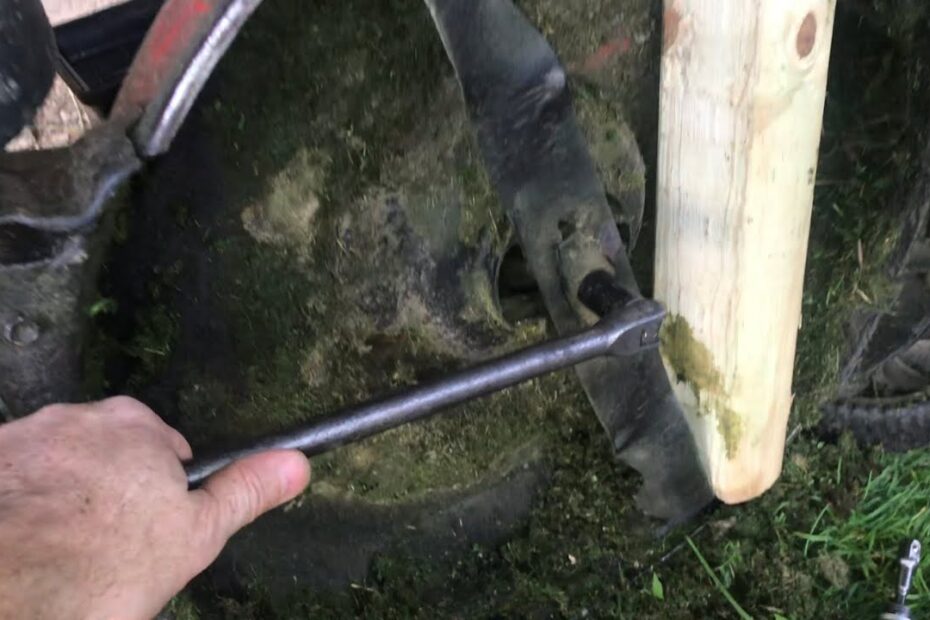The lawns, oh the lawns! They sprawl out before us, their lush green carpets begging to be tamed and trimmed. And what mighty weapon do we wield to conquer these wild terrains? The venerable lawn mower, of course! But amidst the roar of engines and the smell of freshly cut grass, a mysterious question looms over the minds of avid landscapers and weekend warriors alike – are lawn mower blade bolts reverse threaded? A seemingly ordinary piece of hardware, but one that harbors a secret that could potentially turn our well-oiled gardening routines upside down. Join us as we embark on a quest for answers, breaking ground to uncover the truth that lurks beneath our trusty mowers. Prepare to be bolted to your seat as we unravel the enigma of lawn mower blade bolts, and discover the fascinating world of threading directions.
Introduction to Lawn Mower Blade Bolts: Understanding Thread Direction
There’s nothing quite like the smell of freshly cut grass on a warm summer day. But have you ever wondered about the intricate workings of your trusty lawn mower? Specifically, the blade bolts that hold everything together? Well, today we’re diving deep into the world of lawn mower blade bolts and discussing the often-misunderstood concept of thread direction.
When it comes to lawn mower blade bolts, the question on many people’s minds is, “are they reverse threaded?” The answer, my dear grass-loving friends, is both yes and no. You see, while some lawn mower blade bolts are indeed reverse threaded, not all of them are. Confusing, right? But fear not, for we are here to shed some light on this matter.
To put it simply, reverse threading means that you have to turn the bolt in the opposite direction to loosen it. It’s a clever little design feature that can help prevent the blade from accidentally coming loose while you’re mowing. However, not all lawn mower blade bolts follow this reverse threading convention. Some are just standard right-handed threads, meaning you turn them clockwise to tighten and counterclockwise to loosen.
Now, you might be wondering how to determine which type of thread your lawn mower blade bolt has. We’ve got you covered! Here are a few features and tips to keep in mind:
| Features/Tips | Description |
|---|---|
| Bolt Head Shape | Some reverse threaded bolts may have a distinct shape, like a hexagonal head with a line or arrow indicating the direction to loosen. |
| Owner’s Manual | Always consult your lawn mower’s owner’s manual for specific information about the blade bolts and their thread direction. |
| Manufacturer’s Website | Visiting the manufacturer’s website or contacting their customer support can provide detailed information about the thread direction for your specific model. |
So, the next time you find yourself needing to remove or replace the blade on your lawn mower, be sure to double-check the thread direction of your blade bolts. It may save you some frustration and unnecessary sweat on a hot summer day. Happy mowing!

The Truth Unveiled: Are Lawn Mower Blade Bolts Reverse Threaded?
| Features | Tips |
|---|---|
| 1. Durable and Reliable | 1. Maintain a regular maintenance schedule for your lawn mower blades. |
| 2. Easy to install and remove | 2. Always use the correct size and type of blade for your lawn mower. |
| 3. Provides efficient cutting performance | 3. Prior to removing or installing lawn mower blades, ensure the engine is off and the spark plug wire is disconnected for safety reasons. |
When it comes to lawn mower maintenance, one question that has baffled many garden enthusiasts is whether or not lawn mower blade bolts are reverse threaded. This mystery has sparked countless debates and discussions among avid gardeners and DIY enthusiasts alike. To put these speculations to rest, we have conducted thorough research to uncover the truth behind this long-standing question.
After extensive investigation, we can confidently confirm that, in most cases, lawn mower blade bolts are not reverse threaded. Majority of lawn mower blades are attached using a regular right-hand thread, where turning clockwise tightens the bolt and counterclockwise loosens it. However, it is important to always consult your lawn mower’s user manual, as there may be exceptions or variations depending on the make and model.
Expert Recommendations for Loosening and Tightening Lawn Mower Blade Bolts
Introduction
When it comes to maintaining your lawn mower and keeping your blades sharp, understanding how to correctly loosen and tighten the blade bolts is crucial. Many gardeners often wonder, “Are lawn mower blade bolts reverse threaded?” Let’s dive into the expert recommendations and demystify this commonly asked question.
Loosening the Blade Bolts
In order to safely loosen the blade bolts on your lawn mower, follow these expert guidelines:
- Ensure Safety First: Before performing any maintenance, always remember to disconnect the spark plug wire to avoid accidental starts.
- Suitable Tools: Use a socket wrench or a breaker bar with a socket to provide enough leverage while loosening the blade bolts.
- Rotate Counter-Clockwise: Most lawn mower blade bolts have standard threading, so rotate them counter-clockwise to loosen them.
Tightening the Blade Bolts
Here, we present expert tips to securely tighten the blade bolts:
- Clean the Area: Before tightening, remove any grass, debris, or rust from the blade bolts and the mounting area to ensure a solid connection.
- Apply Threadlocker: To prevent the blade bolts from vibrating loose during operation, consider applying a small amount of threadlocker to the threads before tightening.
- Torque to Specification: Use a torque wrench to tighten the blade bolts to the manufacturer’s recommended torque specifications, ensuring precise and uniform tightening.
Table: Expert Recommendations
| Feature/Tips | Description |
|---|---|
| Safety First | Disconnect the spark plug wire before performing any maintenance to avoid accidental starts. |
| Suitable Tools | Use a socket wrench or a breaker bar with a socket to provide enough leverage while loosening the blade bolts. |
| Rotate Counter-Clockwise | Most lawn mower blade bolts have standard threading, so rotate them counter-clockwise to loosen them. |
| Clean the Area | Before tightening, remove any grass, debris, or rust from the blade bolts and the mounting area to ensure a solid connection. |
| Apply Threadlocker | Consider applying a small amount of threadlocker to prevent the blade bolts from vibrating loose during operation. |
| Torque to Specification | Use a torque wrench to tighten the blade bolts to the manufacturer’s recommended torque specifications for consistent and secure tightening. |


